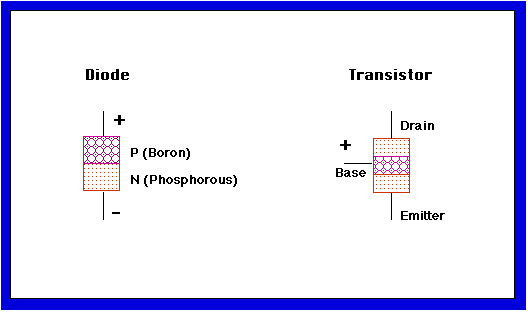
There are numerous physical ways circuits with the 0,1 property of binary numbers can be constructed: a magnet has a north and a south pole, a switch is either open or closed. The circuits could use electricity, fluids, light, or possibly even biological circuits at the atomic level. The current primary technology is electronic and employs a device called a transistor. To understand what a transistor is you must first understand what a diode is. A diode is a device which transmits a current only one way. While there are many ways of constructing diodes let us consider the silicon semiconductor technology. Consider diagram on the next page. One block of silicon is doped with boron and the other with phosphorus. The silicon atoms are bonded together in a lattice with 8 electrons in the outer shell. Doping with phosphorus replaces some of the silicon atoms with phosphorus atoms which means there is a free electron. Doping with boron leaves the lattice one electron short creating a plus charge. Only one combination of plus and minus voltage will produce a current across the diode. If the + is attached to the p (boron) end and the - to the n (phosphorus) end the + repels the positive charges and the repels the electrons resulting in an electron flow across the device. In the opposite case the charges in each half are attracted to the terminal and no current flows. The diode possesses an asymmetric property which is the basis for the 0,1's needed for manipulating binary numbers. A transistor, two diodes placed end to end, provides an asymmetric device which amplifies the input signal. A positive voltage at the base allows current to flow from the emitter to the collector. A negative voltage at the base causes no current flow. The transitor pictured is a pnp transitor. There is also a npn transitor which is activated by a drop in voltage.
